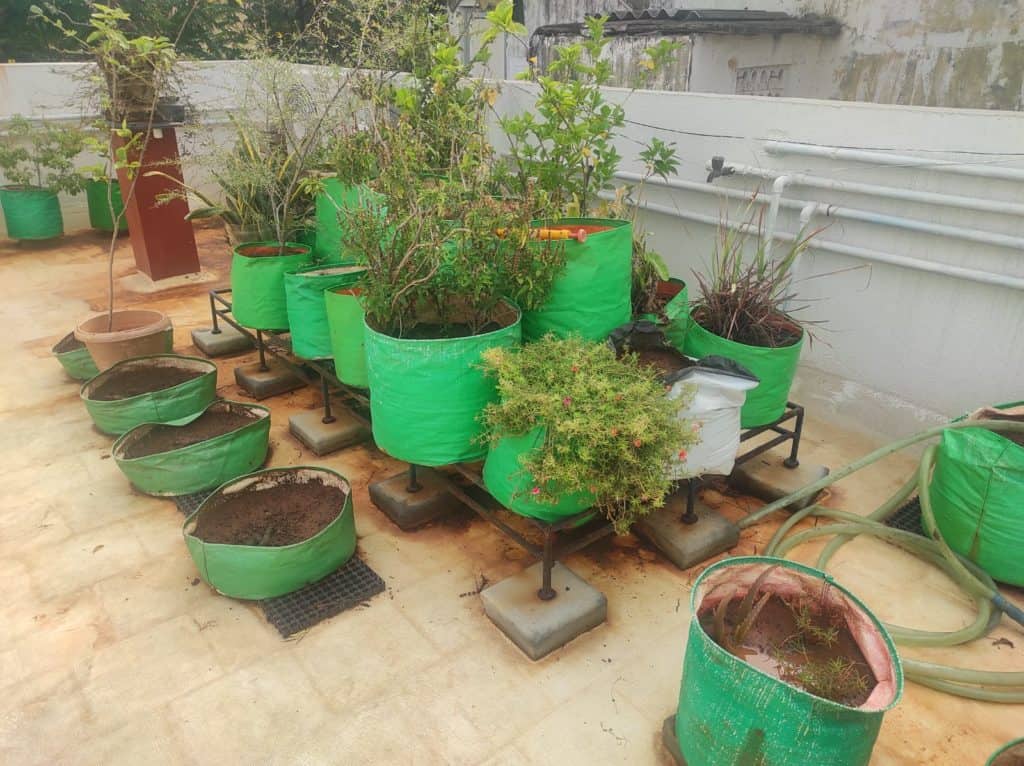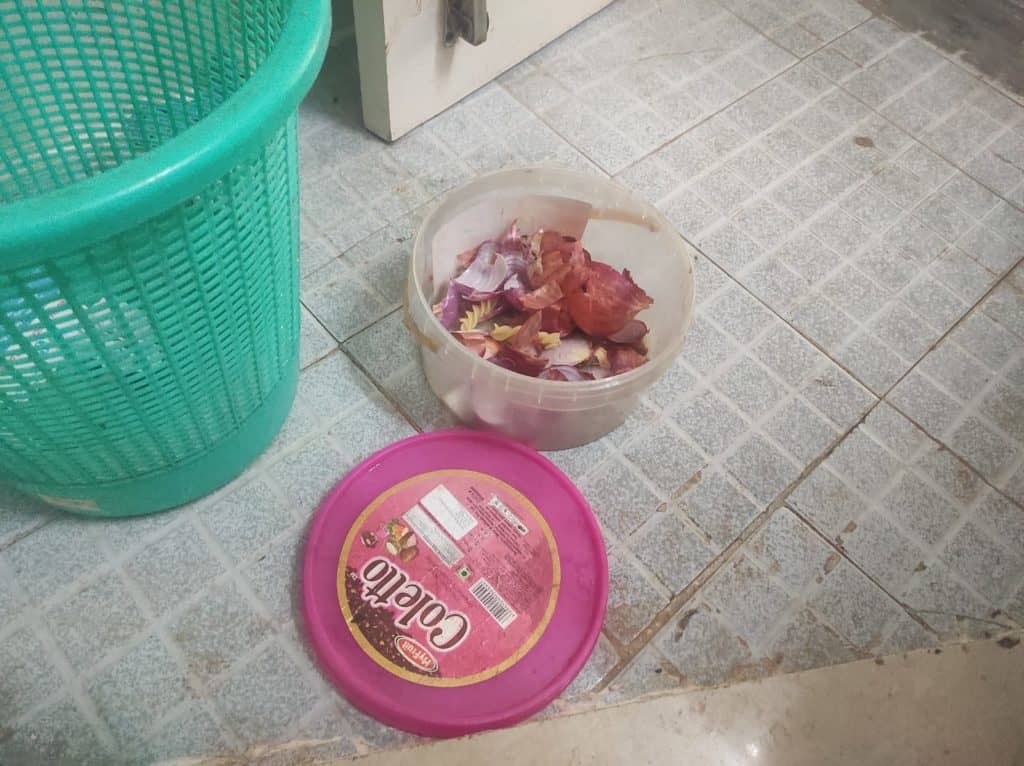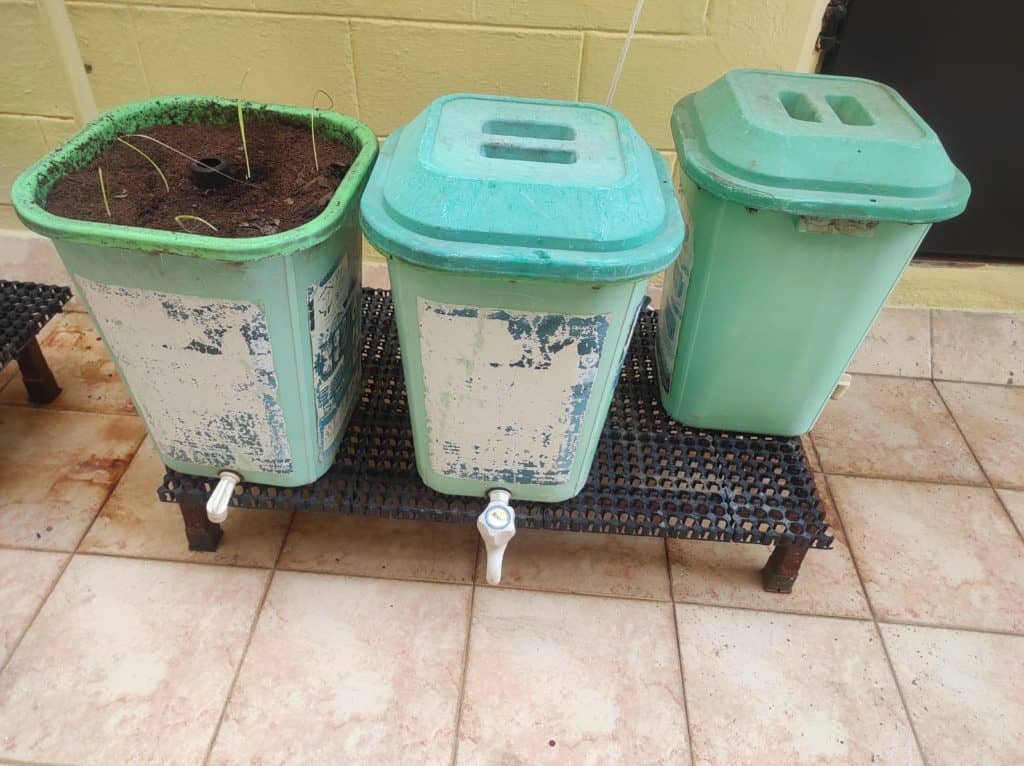Two similar scenes were unfolding one after another in AGS Colony, Velachery West. A garbage collection worker was unloading unsegregated waste into a bin on the street. Ten metres away, Geetha Ganesh Karthik emptied segregated kitchen waste into her home composting set-up.
But these two streams of waste will follow very different paths with different results. The former will end up in a dump yard while the latter will yield manure, enabling the growth of 200 plants.
Geetha has been recycling her kitchen waste by composting it since 2016. If not for her terrace garden, she would be spending around Rs 1500 for flowers a month. “Today, I hardly spend on flowers, unless it is a festival where I may need more,” she said.
Setting up an in-house system for home composting
“Home composting is no rocket science,” said Jayanthi Premchandar from Valmiki Nagar, Thiruvanmiyur. She added that if done methodically, anyone can compost wet waste successfully.
Composting is a process where food waste, vegetable and fruit peels, and other organic materials degrade with the help of microorganisms to form manure.
The preliminary step for composting is waste segregation. Jayanthi and Geetha have separate bins where they put away kitchen waste. “We need to set up a system in the house to collect wet waste separately. My kitchen waste bin is near the sink,” said Jayanthi.
She did not buy colour-coded bins at home and repurposed whatever containers she had into bins.
It is ideal to compost raw vegetable and fruit peels.
“If there is cooked waste, the watery portions must be filtered. If it is rasam or sambar, only the solid portion is to be used for composting,” said S Rukmani, founder of AWCEM, an NGO working on best practices in waste management. She added that the inclusion of soggy and watery food waste would slow down the composting process and invite maggots to breed.
“For best results, cooked waste can be sundried before composting, leading to quicker and more effective home composting”, said B Samuel Jacob, Assistant Professor of Biotechnology at SRM Institute of Science and Technology.
Jayanthi also usually adds eggs in the compost bin. “We should crush the eggs finely before adding them to the compost bin. If not, it will take a very long time for eggshells to be composted,” guided Rukmani.
“Adding bones will not affect the composting process”, said Dr Samuel. “One can do away with bones, but crushing them is necessary if added for composting.”
“I also add paper by tearing them into smaller bits, especially date sheets,” said Geetha. She also included the household dust generated by cleaning and sweeping her house, into the compost bin.
Spoiled dairy products can also be used during composting. As sour curd or buttermilk have favourable microorganisms responsible for the degradation of wet waste, it facilitates faster composting.
Although some experts say that citrus waste can hamper the composting process by killing favourable microorganisms, Geetha and Jayanthi said they add them to their compost bins as they have not faced any issues.
“Addition of small amounts of citrus waste is permissible, and will not create a large impact on the composting process,” said Dr Samuel.
“Even though it may reduce the quality of the compost somewhat, at least it is not ending up in a landfill. That is my main motto of composting,” said Jayanthi.
Read more: Upcycling: A citizen’s guide to creatively reducing landfill waste
Prepping for home composting
After ensuring that the kitchen waste is separated, one must finely chop the materials that would go inside the compost bin. Rukmani uses a food processor for this. “The particle size must be small for easier microbial degradation,” said Dr Samuel.
Jayanthi has bought three composting bins of capacity 20 litres, costing a little more than Rs 2700. Apart from that, she also purchases 10 kilograms of a mixture of cocopeat and microbes, from a local organisation working on waste management. It comes in the form of a brick and costs her around Rs 700. “It lasts me for seven months,” said Jayanthi.
“I add some water to it so that it disintegrates and becomes a powder,” said Geetha, who also buys the cocopeat and microbe mix. She stores it in a large tin and uses it as and when necessary.
The compost set-up must ideally be in an area with shade, per Dr Samuel.
Home composting set-up at a low cost
One can either buy composting bins for home composting or create their own set-up at home. A composting bin is usually a cylindrical plastic container that consists of a tap at the bottom.
Dr Samuel showed how to make the composting bin at home by reusing a large water can and water dispenser. “You only have to invest around Rs 100 to Rs 200 to modify the water can and use it as a composting bin,” he said.
Watch the video below to learn how to make a compost bin with a water can and dispenser.
Instead of cocopeat, one can use garden waste and add a little bit of spoiled curd or buttermilk, he said.
How to go about home composting?
Looking to start composting wet waste at home? Follow these easy steps recommended by experts and practitioners.
- Add soil as the first layer to the compost bin.
- Layer the finely chopped kitchen waste next.
- Cover that layer completely with cocopeat mixture or dry waste, soil and spoiled dairy products.
- Layer the kitchen waste next. The kitchen waste must be layered between dry waste (or cocopeat).
- Close the bin to avoid infestation of insects and maggots. This will also prevent any stench from the composting process.
- Stir the mixture every three to four days in the composting bin such that the top layer moves to the bottom and vice versa to ensure uniform composting.
- Composting is a process that will give out moisture in the form of leachate. It can be collected on alternate days. “One part of the leachate can be mixed with ten parts of water that can be sprayed on plants as a natural insecticide,” explains Jayanthi.
- It takes 35-40 days for the wet waste and the dry waste to form a brownish-black homogeneous powder- manure. At that stage, it must be taken out and dried in the sun in a thin layer, until the moisture evaporates. One can dry it on their terrace or balcony.
- The manure is ready to be used to enhance soil fertility for gardening.
When one compost bin is three-fourths full, Jayanthi begins composting in the second bin and so on. When the third bin is almost full, she empties the first bin where the waste would have turned into manure.
“Personally, there are no major challenges in composting,” said Jayanthi.
“During rainy season, the composting process takes longer, even up to 60 days, and the manure does not dry easily,” said Geetha.
Is composting possible in apartments?
Jayanthi has her composting set up in a corner of her balcony in her apartment. “If someone feels they are unable to compost in apartments, they should make the effort to go and study other composting units in similar houses. It is possible,” said Jayanthi.
Rukmani has her set up it inside the house, near the dining table. “There is no ill odour or insects because of the compost bin. If one does the process systematically, the composting will give out a pleasant, earthy smell,” she said.
“Composting is one of the most economical methods of recycling kitchen waste when compared to options such as setting up biogas plants”, said Dr Samuel.
Read more: How to produce biogas from kitchen waste and reduce your LPG bills
A community initiative for home composting
Last year, residents of Chitlapakkam started a WhatsApp group for people with gardens, to create awareness about composting and gardening. “The group had 70 members initially, and today it has 160,” said Dayanand Krishnan, a resident. The group aimed to ensure smooth management of waste and prevent contamination of the nearby lake.
“We must have reached out to around 1000 houses about home composting. We saw that waste was being dumped in our lake in 2021 and wanted to act on it,” he said. “On the formation of the group and encouragement by fellow residents, many have taken to home composting in the area. The waste handed over to solid waste management personnel has been reduced by 40% because of home composting.”
“Our ultimate aim is that at least half the population of Chitlapakkam must start composting kitchen waste in their homes,” said Dayanand.




